
* A jet trainer / light attack aircraft may not be the same sort of status symbol as a first-line fighter jet, but the need to perform adequate flight training and the low cost, ease of maintenance, and combat effectiveness of light attack aircraft has ensured that the trainer-attack type is in common use over the world. One of the most prominent of the trainer-attack types was the Cessna "T-37/A-37", known in various forms as the "Tweety Bird", "Tweet", "Dragonfly", or "Super Tweet". This small, neat aircraft flew for decades as a primary trainer for the US Air Force, and served with distinction in the attack role during the Vietnam War. The T-37/A-37 has also provided excellent service in the air forces of other nations.
This document provides a history and description of the T-37/A-37, as well as of the comparable Canadian Canadair "CL-41 Tutor".
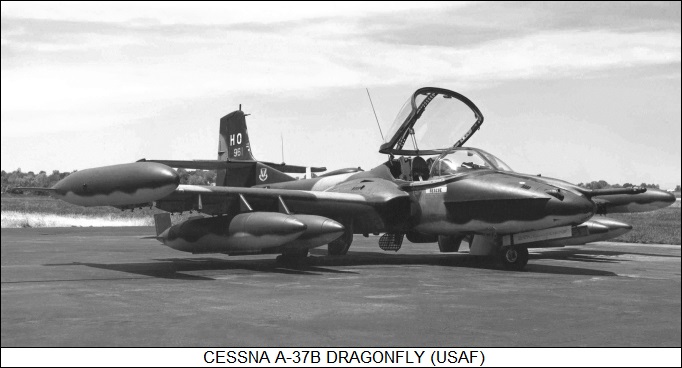
* The Cessna Aircraft Company of Wichita, Kansas, earned a good reputation with the US Army during World War II with the company's excellent utility, light transport, and observation aircraft, particularly the "O-1 Bird Dog" series.
In the spring of 1952, the US Air Force (USAF) issued a request for proposals for a "Trainer Experimental (TX)" program, specifying a lightweight two-seat basic trainer for introducing USAF cadets to jet aircraft. Cessna responded to the TX request with a twin-jet design that featured side-by-side seating. The USAF liked the Cessna design, which was given the company designation of "Model 318", and particularly liked the side-by-side seating since it allowed the student and instructor to interact more closely than would be possible with tandem seating. In the spring of 1954, the USAF awarded Cessna a contract for three prototypes of the Model 318, along with a separate contract for a single static test aircraft. The Air Force assigned the designation of "XT-37" to the type.
The first XT-37 performed its initial flight in October 1954. The aircraft featured a straight low wing, with the engines buried in the wing roots; a clamshell-type canopy that opened upward, hinged on the rear.; a control layout similar to that of contemporary operational USAF aircraft; ejection seats; and tricycle landing gear with a wide track of 4.3 meters (14 feet). The wide track and a steerable nosewheel made the aircraft easy to handle on the ground, and the short landing gear eliminated the need for access ladders and service stands. The aircraft was designed to be simple to maintain, featuring more than a hundred access panels and doors. An experienced ground crew could change an engine in about a half hour.
The XT-37 was very aerodynamically clean, and so an air brake was fitted behind the nosewheel door to reduce landing speed. Given that the landing gear was short and the engine intakes were consequently close to the ground, the XT-37 was equipped with screens that pivoted up over the intakes from underneath when the landing gear was extended to block foreign object ingestion.
The XT-37 was fitted with two Continental-Teledyne J69-T-9 turbojet centrifugal-flow turbojets with 4.1 kN (420 kgp / 920 lbf) thrust each. These were actually French Turbomeca Marbore engines, built under license. The engines incorporated exhaust thrust deflectors so they could remain spooled up during landing approach, permitting shorter landings while still allowing the aircraft to easily make another "go-round" in case something went wrong. Total weight of the XT-37 was 2.27 tonnes (5,000 pounds). Tests showed the XT-37 had a maximum speed of 630 KPH (390 MPH) at altitude, with a range of 1,500 kilometers (935 miles). The aircraft was unpressurized, and so was limited to a ceiling of 7.6 kilometers (25,000 feet) by USAF regulations.
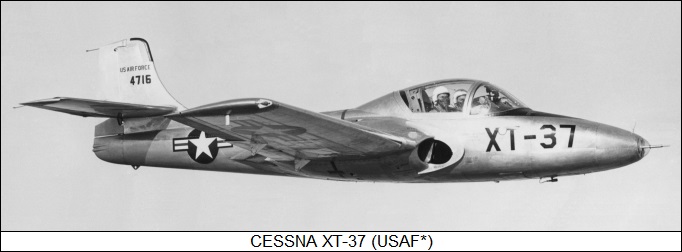
* The initial prototype crashed during spin tests. The later prototypes incorporated new features to improve handling, including long strakes along the nose, and an extensively redesigned and enlarged tail. After these modifications, the USAF found the aircraft acceptable to their needs, and ordered it into production as the "T-37A".
BACK_TO_TOP* The production T-37A was similar to the XT-37 prototypes, except for minor changes to fix problems revealed by the flight test program. The first T-37A was completed in September 1955, and was delivered to the Air Force in June 1956. The USAF began cadet training in the T-37A during 1957.
Instructors and students found the T-37A extremely pleasant to fly. It handled well and was agile and responsive, though it was definitely not overpowered. It was capable of all traditional aerobatic maneuvers. The T-37A did have one noticeable and obnoxious defect: it was very noisy, even by the standards of a jet aircraft. Its little turbojets emitted a high-pitched shriek that led some to describe the trainer as a "Screaming Mimi", and it was referred to as the "6,000 pound dog whistle". The piercing whistle quickly gave the T-37 its name: "Tweety Bird", or just "Tweet".
The Air Force ordered 444 T-37As, with the last produced in 1959. During 1957, the US Army evaluated three T-37As for battlefield observation and other combat support roles, but eventually procured the Grumman OV-1 Mohawk for the mission instead.
* The Air Force liked the T-37A, but the lack of power was a serious defect. As a result, the service ordered an improved version, the "T-37B", with uprated J69-T-25 engines. The new engines provided about ten percent more thrust and better reliability. Improved avionics were also specified for the new variant. The first T-37B was delivered in 1959. A total of 552 new-build T-37Bs was built through 1973, and all surviving T-37As were eventually upgraded to the T-37B standard as well.
___________________________________________________________________
CESSNA T-37B:
___________________________________________________________________
wingspan:
10.32 meters (33 feet 10 inches)
wing area:
17.09 sq_meters (183.9 sq_feet)
length:
8.92 meters (29 feet 3 inches)
height:
2.79 meters (9 feet 2 inches)
empty weight:
1,840 kilograms (4,056 pounds)
max loaded weight:
2,980 kilograms (6,570 pounds)
maximum speed:
685 KPH (425 MPH / 370 KT)
service ceiling:
7,620 meters (25,000 feet)
range:
1,500 kilometers (930 MI / 810 NMI)
___________________________________________________________________
Due to a series of accidents caused by bird strikes between 1965 and 1970, all T-37s were later retrofitted with a new windscreen made of Lexan polycarbonate plastic 12.5 millimeters (a half inch) thick. The new windscreen was capable of tolerating the impact of a 1.8-kilogram (4-pound) bird at a relative speed of 460 KPH (288 MPH).
In 1962, Cessna suggested the T-37B as a replacement for the North American F-100 Super Sabre as the mount for the USAF aerobatic demonstration team, the Thunderbirds. The T-37B was an excellent aerobatic aircraft, was economical to operate and support, and could be flown from small airports. However, the Air Force was happy with the thunderous F-100, and was not interested in trading it in for the shrill Tweet.
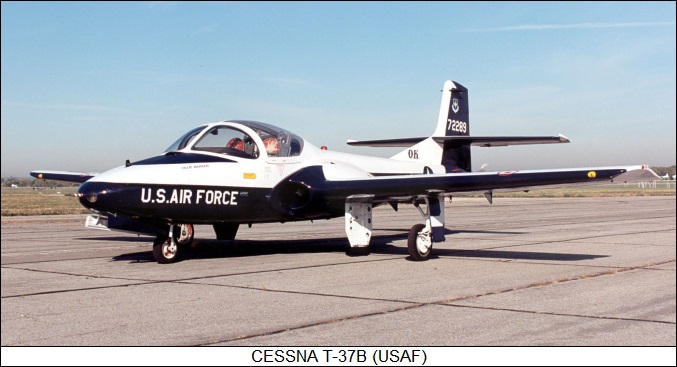
* The T-37A and T-37B had no built-in armament and no stores pylons for external armament. In 1961, Cessna began development of a modest enhancement of the T-37 for use as a weapons trainer. The new variant, the "T-37C", was intended for export and could be used for light attack duties in a pinch.
The prototype T-37C was actually a modified T-37B. The primary changes included stronger wings, with a stores pylon under each wing, outboard of the main landing gear well. The T-37C could also be fitted with wingtip fuel tanks, each with a capacity of 245 liters (65 US gallons), that could be dropped in an emergency.
A computing gunsight and gun camera were added. The T-37C could also be fitted with a reconnaissance camera mounted inside the fuselage. The primary armament of the T-37C was the General Electric "multi-purpose pod", which carried a 12.7-millimeter (0.50-caliber) Browning machine gun with 200 rounds; two 70-millimeter (2.75-inch) folding-fin unguided rockets; and four practice bombs. Other stores, such as folding-fin rocket pods or even in principle Sidewinder air-to-air missiles, could be carried as well. The changes increased the weight of the T-37C by 650 kilograms (1,430 pounds). Since the engines were not upgraded, this reduced top speed to 595 KPH (370 MPH), though the wingtip tanks increased maximum range to 1,770 kilometers (1,100 miles).
* T-37s, including both new-build and ex-USAF aircraft, were supplied to a number of foreign operators, including:
T-37 production ended in 1975. The list of exports above amounts to 273 T-37Cs; adding this to the 444 T-37As and 552 T-37Bs gives a total of 1,269 aircraft built. The type remained in service with the USAF into the 21st century, having survived various attempts to find a replacement. However, the Tweet was finally phased out in favor of the turboprop-powered Raytheon T-6A, going into retirement after over four decades of reliable service.
By 2015, the Tweet had been retired from training service in all countries except Colombia and Pakistan -- which had obtained 20 retired machines from the US in 2008, and 34 more provided by Turkey in 2016.
BACK_TO_TOP* The growing American military involvement in Vietnam in the early 1960s led to strong interest in "counter-insurgency (COIN)" aircraft, and in late 1962 the US Air Force's Special Air Warfare Center at Eglin AFB in Florida evaluated two T-37Cs for the role. The Air Force found the T-37 promising, but wanted an improved version of the aircraft that could carry a much larger warload and provide had much greater endurance, as well as better short-field performance. That meant a heavier aircraft with more powerful engines, and during 1963 the Air Force awarded a contract to Cessna for two T-37s with the necessary modifications.
The two prototypes were given the designation of "YAT-37D". Changes included:
The changes meant a drastic increase in aircraft weight, and the aircraft now had to carry a serious warload as well, so Cessna replaced the two Continental J-69 engines with General Electric J85-J2/5 turbojet engines, providing 10.7 kN (1,090 kgp / 2,400 lbf) thrust each -- twice as powerful as the old Continental J69s.
The first YAT-37D flew in October 1964, followed a year later by the second prototype. The second prototype had four stores pylons under each wing, instead of three, and the first prototype was upgraded to this configuration as well. Test results were good, but USAF interest in COIN aircraft had faded for the moment. The program went into limbo for a time, with the second prototype "put out to pasture" at the Air Force Museum at Wright-Patterson Air Force Base in Ohio.
However, the war in Southeast Asia continued to escalate. Losses of Douglas A-1 Skyraider close-support aircraft in US and South Vietnamese hands proved greater than anticipated, and so USAF interest in COIN aircraft revived. The YAT-37D seemed like a promising candidate for the job, but the Air Force felt the only way to be sure was to evaluate the aircraft in combat. As a result, the USAF issued a contract to Cessna for a pre-production batch of 39 YAT-37Ds, with a few minor changes relative to the prototypes, to be rebuilt from existing T-37Bs. These aircraft were initially designated "AT-37D", but the designation was quickly changed to "A-37A". The second prototype YAT-37D was yanked out of the Air Force Museum and upgraded to A-37A standard as part of the test program.
The A-37A had a gross take-off weight of 5,440 kilograms (12,000 pounds), of which 2,130 kilograms (4,700 pounds) was warload. The A-37A retained the dual controls of its T-37B ancestor, allowing it to be used as an operational trainer. In combat "forward air control (FAC)" operations, the second seat was occupied by an observer. Only one crew member normally flew in the aircraft for close-support missions, permitting a slight increase in warload.
In August 1967, 25 of the A-37As were sent to Vietnam under the COMBAT DRAGON evaluation program, and flew from Bien Hoa Air Force Base on USAF "air commando" missions, including close air support, helicopter escort, FAC, and night interdiction. Warloads included high-explosive bombs, cluster munition dispensers, unguided rocket packs, napalm tanks, and the SUU-11/A Minigun pod. For most missions, the aircraft also carried two additional external tanks on the inner stores pylons.
The A-37As flew thousands of sorties. None were lost to enemy fire, though two were wrecked in landing accidents. The A-37A was formally named the "Dragonfly", but most pilots called it the "Super Tweet". It is an interesting question if that meant the A-37A was even noisier than the T-37.
BACK_TO_TOP* The Combat Dragon program was very successful, but unsurprisingly the combat evaluation revealed deficiencies in the A-37A. The worst problem was that the aircraft lacked range and endurance. Other concerns were heavy control response during attack runs and the vulnerability of the aircraft's non-redundant flight control system.
The USAF signed a contract with Cessna in early 1967 for an improved Super Tweet, designated the "A-37B". The initial order was for 57 aircraft, but this was quickly increased to 127. The A-37Bs were primarily to be supplied to the South Vietnamese Air Force as replacements for their Skyraiders. The A-37B prototype was rolled out in September 1967, with deliveries to the South Vietnamese beginning in 1968.
___________________________________________________________________
CESSNA A-37B:
___________________________________________________________________
wingspan:
10.94 meters (35 feet 10 inches)
wing area:
17.09 sq_meters (183.9 sq_feet)
length (no probe):
8.92 meters (29 feet 3 inches)
height:
2.82 meters (9 feet 3 inches)
empty weight:
2,815 kilograms (6,210 pounds)
max loaded weight:
6,800 kilograms (15,000 pounds)
maximum speed:
815 KPH (505 MPH / 440 KT)
service ceiling:
12,700 meters (41,800 feet)
range:
1,480 kilometers (920 MI / 800 NMI)
___________________________________________________________________
The A-37Bs were all new-build aircraft. The A-37B was stronger than the A-37A, stressed to 6 gees instead of 5, and had a longer fatigue life of 4,000 hours. Field experience would show that 7,000 hours was more in line with reality.
The A-37B weighed almost twice as much as the T-37C. A remarkable fraction of the loaded weight, 2.67 tonnes (5,880 pounds), could be external stores. In practice, the A-37B usually operated with at least two and sometimes four underwing fuel tanks to improve combat endurance. 20-millimeter and 30-millimeter cannon pods were developed for the A-37B to give it more punch, but apparently such pods were rarely if ever carried in operation.

To get this greater weight off the ground, the A-37B was fitted with General Electric J85-GE-17A engines, providing 12.7 kN (1,300 kgp / 2,850 lbf) thrust each, almost 20% more than the thrust provided by the J85s fitted to the A-37A. These engines were canted slightly outward and downward to improve single-engine handling. Air commando pilots in Vietnam operating the A-37A had found single-engine cruise an effective means of improving their flight endurance.
Modifications were made to control surfaces to improve handling. To improve aircraft and crew survivability, the A-37B was fitted with redundant elevator control runs that were placed as far apart as possible. The ejection seats were armored, the cockpit was lined with nylon flak curtains, and foam-filled self-sealing fuel tanks were installed. The A-37B added a mid-air refueling probe to the nose, leading to pipes wrapped around the lower lip of the canopy. Other improvements included updated avionics, a redesigned instrument panel to make the aircraft easier to fly from either seat, an automatic engine inlet de-icing system, and revised landing gear. Like its predecessors, the A-37B was not pressurized.
* A total of 577 A-37Bs was built, with 254 delivered to the South Vietnamese Air Force. They reportedly performed well in actions against Communist forces. When South Vietnam fell in early 1975, a South Vietnamese Air Force officer, Captain Nguyen Thanh Trung, defected to the Communists and led strikes against South Vietnamese government positions in his A-37B. There were about 187 A-37Bs in South Vietnamese hands when the country fell. 92 were recovered by the Americans, while the other 95 were later used by the Communist Vietnamese in missions over Cambodia. These "renegade" aircraft were phased out of service in the late 1970s or early 1980s, no doubt due to lack of spares. Some were evaluated by Soviet test pilots before the machines were retired.
After the war, the USAF passed their A-37Bs from the USAF Tactical Air Command to Air National Guard and Air Force Reserve units. In the early 1980s, these aircraft were assigned the FAC role and given the designation "OA-37B". Panama-based USAF OA-37Bs flew combat support missions during Operation JUST CAUSE in 1989, the US effort to oust Panamanian strongman Manuel Noriega; they performed some attacks, but it appears they were generally there to make noise and intimidate Panamanian troops. The OA-37Bs were eventually phased out and replaced in the FAC mission by the much more formidable Fairchild OA-10A Warthog.
The A-37B was also exported to Latin American air arms, mostly during the 1970s. It was well suited to their needs because of its simplicity, low cost, and effectiveness for insurgent warfare. Most of the A-37Bs exported south had the refueling probe shortened to act as a single-point ground refueling probe, or deleted completely. Latin American countries that received the A-37B included:
Super Tweets remain in service in some of these countries in slowly declining numbers.
* The following list summarizes T-37 / A-37 variants and production:
* Cessna proposed a number of interesting variants of the Tweet that never went into production. In 1959, Cessna built a prototype of a light jet transport version of the T-37, designated the Cessna "Model 407", which was stretched 60 centimeters (two feet) to accommodate a four-place pressurized cockpit with an automobile-type configuration. The prototype performed well in tests, but Cessna couldn't find any buyers. The company also proposed a similar four-place military light transport, the "Model 405", with a big clamshell canopy, but it was never built.

In response to a US Navy "Tandem Navy Trainer (TNT)" requirement, Cessna proposed a T-37 with a modified fuselage featuring a tandem cockpit. The Navy chose the North American T-2 Buckeye instead, and the Cessna concept never got off the drawing board. Cessna proposed various other trainer derivatives for the US Navy and Air Force, including a vertical take-off version based on the TNT configuration and incorporating lift-jet pods in the wings, but none of them got to the prototype stage.
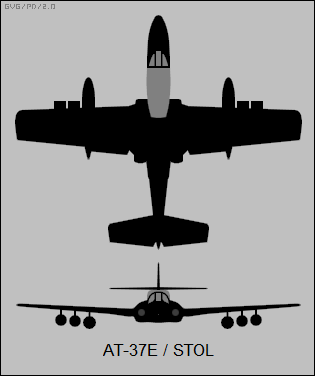
Cessna also proposed enhanced strike variants of the T-37. The "AT-37E/STOL" (short take-off & landing) concept incorporated more powerful engines, thrust reversers, and big flaps. Side-by-side and tandem seating versions were offered. The "A-37D" had more powerful engines, a centerline gun pod, and a single-seat configuration based on the TNT fuselage. As with the improved trainer concepts, the improved strike versions never flew.
BACK_TO_TOP* While the USAF was obtaining the T-37, Canadair of Canada was developing a very comparable side-by-side jet trainer, the "Canadair CL-41 Tutor".
The CL-41 began as a company-funded venture, with initial flight of the first of two prototypes in 1960. Both the prototypes were powered by a single Pratt & Whitney JT12A-5 turbojet with 10.7 kN (1,090 kgp / 2,400 lbf) thrust. The type attracted the interest of the Royal Canadian Air Force (RCAF), leading to a contract for 190 "CL-41A" production aircraft, fitted with the more powerful General Electric J85-CAN-40 turbojet with 12.6 (1,290 kgp / 2,850 lbf) thrust. Production began in 1963, with last deliveries to the RCAF in 1966.

The Tutor is a neat little machine, a low-wing aircraft with a tee tail, engine inlets in the wing roots, an exhaust in the tail, and strakes along the sides of the nose. Control layout is conventional, with rudder, elevators, ailerons, and one-piece flaps; there is an air brake along each side of the rear fuselage. The Tutor features tricycle landing gear, all assemblies with single wheels, the nose gear retracting forward and the main gear hinged in the wings to retract towards the fuselage. The cadet and instructor sit under a clamshell canopy that opens upward, hinged on the rear. There is a baggage storage compartment on each engine intake fairing, with a door that hinges up from the top of the fairing.
___________________________________________________________________
CANADAIR CT-114 (CL-41A) TUTOR:
___________________________________________________________________
wingspan:
11.13 meters (36 feet 6 inches)
wing area:
20.44 sq_meters (220 sq_feet)
length:
9.75 meters (32 feet)
height:
2.84 meters (9 feet 10 inches)
empty weight:
2,220 kilograms (4,895 pounds)
max loaded weight:
3,532 kilograms (7,788 pounds)
max speed at altitude:
755 KPH (500 MPH / 435 KT)
ceiling:
13,100 meters (43,000 feet)
range:
1,000 kilometers (625 MI / 540 NMI)
___________________________________________________________________
The Tutor, now designated the "CT-114", still remains in Canadian service. 156 surviving Tutors were put through an upgrade program in the late 1970s, which included the addition of external fuel tanks and an improved canopy, avionics, electrical system, and engine-ice detection system. Although the Tutor is not the most prominent jet trainer built, it has nonetheless achieved distinction as the mount for the RCAF "Snowbirds" aerobatic demonstration team. Their nine distinctively-painted red-and-white Tutors have been a crowd-pleaser at airshows all over the world for decades.
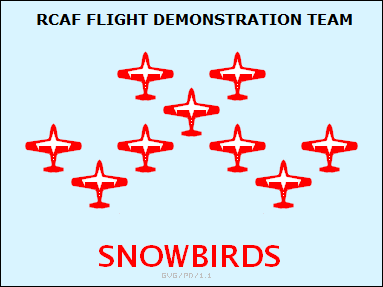
* Canadair, like most other manufacturers of jet trainers, also produced a light attack variant of the Tutor, the "CL-41G". The primary differences from the CL-41A were the fit of an uprated GE J85-J4 turbojet with 13.1 kN (1,340 kgp / 2,950 lbf) thrust; larger wheels for rough-field operation; and three stores pylons under each wing, for a total of six. The CL-41G had no built-in armament, but it could carry gun pods on the stores pylons. It could carry an external load of up to 1,815 kilograms (4,000 pounds). Illustrations show a fairing on the underside that suggested a doppler radar altimeter system.
Malaysia bought 20 CL-41Gs, which were known in Malaysian service as the "Tebuan (Wasp)". Deliveries began in 1967, with the type remaining in Malaysian service into the 1980s. Canadair also proposed a "radar trainer" variant of the Tutor, the "CL-41R", with a "needle nose" containing the NASARR multi-mode radar used on the RCAF's Lockheed CF-104 Starfighters. The company modified one of the two original CL-41 prototypes to the CL-41R configuration, but the RCAF didn't buy off on it.
BACK_TO_TOP* There was a footnote to the T-37, with Cessna later flying another jet trainer, though it didn't enter production. In the early 1990s, the USAF and US Navy initiated a "Joint Primary Aircraft Training System (JPATS)", the goal being to obtain a primary trainer for both services. There was some discussion between the two services on whether side-by-side or tandem seating was specified, but tandem seating won out. Seven companies submitted designs, the Cessna design being the "Model 526 Citationjet". Initial flight of the prototype was on 20 December 1993, with a pre-production example flying the next year.
The Cessna 526 was derived from the Cessna 525 Citationjet executive jet, the trainer leveraging off the Model 525's wings, engines, and landing gear, as well as the electrical, hydraulic, and fuel systems. The trainer of course had a completely different fuselage, with a tandem-seat cockpit, and the trainer had a conventional tail assembly, not the tee tail of the executive jet.
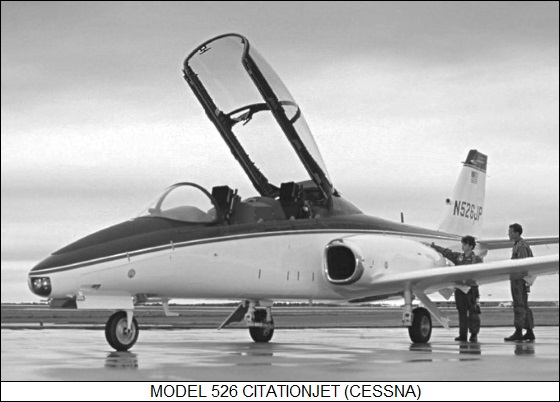
The Model 526 was powered by twin Williams F129 (FJ44) turbofans with 6.7 kN (680 kgp / 1,500 lbf) thrust each, each engine being fitted in a nacelle on the fuselage above the wingroot. It had tricycle landing gear, all gear with single wheels and hydraulic retraction, the nose wheel retracting forward, the main gear pivoting in from the wings towards the fuselage. The two aircrew sat on zero-zero (zero-speed / zero-altitude) ejection seats, under a rear-hinged single canopy.
___________________________________________________________________
CESSNA 526 CITATIONJET:
___________________________________________________________________
wingspan:
11.28 meters (37 feet)
wing area:
20.3 sq_meters (218 sq_feet)
length:
12.4 meters (40 feet 8 inches)
height:
3.81 meters (12 feet 6 inches)
empty weight:
2,925 kilograms (6,450 pounds)
max loaded weight:
3,855 kilograms (8,500 pounds)
max speed at altitude:
Mach 0.7
ceiling:
11,000 meters (35,000 feet)
range:
1,945 kilometers (1,210 MI / 1,050 NMI)
___________________________________________________________________
Cessna was favored to win the competition, but the award went to Beech / Raytheon for the T-6A Texan II. What happened to the two Citationjets is unclear.
* I have a certain partiality to jet trainers. This is not just because I tend to get a bit bored with fighters and bombers; trainers just look like they would be tremendous fun to fly.
I only saw a Tweet in the air once. A T-37 conveniently flew at low altitude over the top of my house in Loveland, Colorado, heading due south, I suspect on its way to USAF facilities in Colorado Springs. "Good Bob, it really is a Screaming Mimi!"
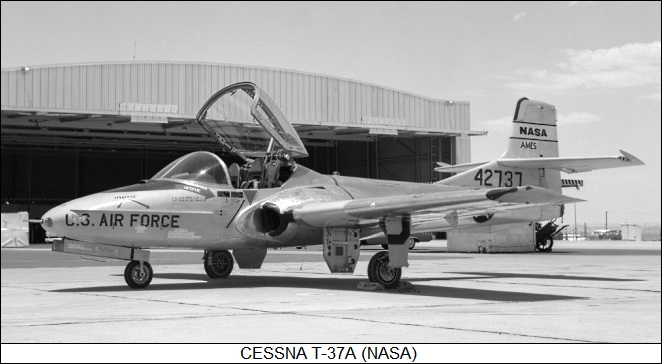
* Although I found scraps of data on the Tweet in a few books, this document is essentially an outline of a single source:
* Revision history:
v1.0 / 01 dec 98 v1.1 / 01 mar 01 / Review & polish. v1.2.0 / 01 nov 02 / Review & polish. v1.2.1 / 01 nov 04 / Review & polish. v1.2.2 / 01 nov 06 / Review & polish. v1.2.3 / 01 oct 08 / Review & polish. v2.0.0 / 01 jul 09 / Added Canadair Tutor. v2.0.1 / 01 jun 11 / Review & polish. v2.0.2 / 01 apr 13 / Review & polish. v2.0.3 / 01 mar 15 / El Salvador buy of 10 Chilean A-37Bs. v2.0.4 / 01 feb 17 / Turkish T-37s to Pakistan. v2.1.0 / 01 jan 19 / CitationJet trainer. v2.2.0 / 01 nov 20 / Illustrations update. v2.2.1 / 01 aug 22 / Review & polish. v2.2.2 / 01 jul 24 / Review & polish. (+)BACK_TO_TOP
